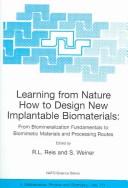| Listing 1 - 1 of 1 |
Sort by
|

ISBN: 1402026447 1402026471 9786610190652 1280190655 140202648X Year: 2005 Volume: 171 Publisher: Dordrecht : Springer Netherlands : Imprint: Springer,
Abstract | Keywords | Export | Availability | Bookmark
 Loading...
Loading...Choose an application
- Reference Manager
- EndNote
- RefWorks (Direct export to RefWorks)
The development of materials for any replacement or regeneration application should be based on the thorough understanding of the structure to be substituted. This is true in many fields, but particularly exigent in substitution and regeneration medicine. The demands upon the material properties largely depend on the site of application and the function it has to restore. Ideally, a replacement material should mimic the living tissue from a mechanical, chemical, biological and functional point of view. Of course this is much easier to write down than to implement in clinical practice. Mineralized tissues such as bones, tooth and shells have attracted, in the last few years, considerable interest as natural anisotropic composite structures with adequate mechanical properties. In fact, Nature is and will continue to be the best materials scientist ever. Who better than nature can design complex structures and control the intricate phenomena (processing routes) that lead to the final shape and structure (from the macro to the nano level) of living creatures? Who can combine biological and physico-chemical mechanisms in such a way that can build ideal structure-properties relationships? Who, else than Nature, can really design smart structural components that respond in-situ to exterior stimulus, being able of adapting constantly their microstructure and correspondent properties? In the described philosophy line, mineralized tissues and biomineralization processes are ideal examples to learn-from for the materials scientist of the future.
Biomineralization --- Prosthesis Design --- Biological compatibility --- Biological tolerance --- Biomedical compatibility --- Biomedical tolerance --- Biotolerance --- Compatibility, Biological --- Compatibility, Biomedical --- Tolerance, Biological --- Tolerance, Biomedical --- Biomedical materials --- Biocompatibility --- Engineering. --- Biotechnology. --- Biochemical engineering. --- Inorganic chemistry. --- Materials science. --- Engineering, general. --- Biochemical Engineering. --- Inorganic Chemistry. --- Characterization and Evaluation of Materials. --- Ceramics, Glass, Composites, Natural Methods. --- Material science --- Physical sciences --- Inorganic chemistry --- Chemistry --- Inorganic compounds --- Bio-process engineering --- Bioprocess engineering --- Biochemistry --- Biotechnology --- Chemical engineering --- Genetic engineering --- Construction --- Industrial arts --- Technology --- Chemistry, inorganic. --- Surfaces (Physics). --- Ceramics, Glass, Composites, Natural Materials. --- Physics --- Surface chemistry --- Surfaces (Technology) --- Ceramics. --- Glass. --- Composites (Materials). --- Composite materials. --- Composites (Materials) --- Multiphase materials --- Reinforced solids --- Solids, Reinforced --- Two phase materials --- Materials --- Amorphous substances --- Ceramics --- Glazing --- Ceramic technology --- Industrial ceramics --- Keramics --- Building materials --- Chemistry, Technical --- Clay --- Implantable biomaterials --- Biomimetic materials
| Listing 1 - 1 of 1 |
Sort by
|

 Search
Search Feedback
Feedback About
About Help
Help News
News